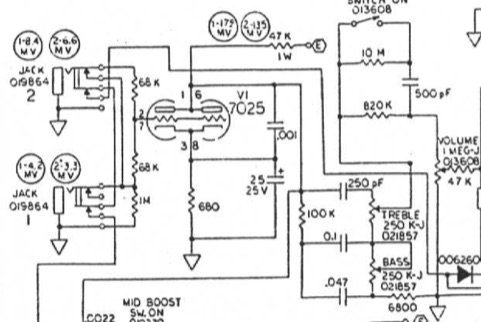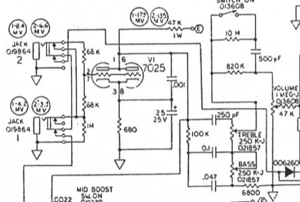Let‘s discuss a Three Channel Amp from Scratch! Actually it is more a monologue - lol. But it may 1) help me to find ideas for my next amp or 2) inspires you to agree or disagree with me 3) or even drives you to discuss with me. Here we go . . .
Let‘s assume we want to build a three channel amp. Which clean, which crunch, what kind of lead channel are we looking for?
A good start for a clean channel is Bogner‘s Shiva or (even better) CAAs Preamp Ch1. The later one would need three triodes or 1.5 ECCs though. An alternative could be a „down gained“ 2 triode setup.
A nice crunch. Something in the 800s direction. Want more meat? Use the X88R crunch/2nd channel circuit. Or BE-ish?
And the lead channel? Well. Could be some SLO derivate or anything Jose? Using diodes to drive 3 800s stages a la Jubilee?
How to solve the problem that V1A for anything fender directed needs bass (a big cathode cap) which may cause anything crunchy or even higher distorted being driven into muddy land?
How not to lose the fenderish feel for a clean channel then?
I will try to post every week something here . . . stay tuned.
Week 1 - Input stage:
General approach: One triode to drive all channels or are there any alternatives like separate triodes for clean and crunch/lead? Normally I would use the first option as it is done in hundreds of multi amps. A simple trick to run in parallel a fenderish clean (means toonestack right after V1As plate) and a typical 800s channel is to use a 47nF coupling cap before the fenderish tonestack and in series a 2n2 cap for the distorted channels.
If you are afraid to lose too much signal when using just one triode to drive all channels - you could use a dual triode input like in Fender Concerts:
I would only recommend to add a 47nF between the 47k plate and the tonestack of channel one and then run thru a 2n2 into the 800s circuitry.
How about channel two then?
Let‘s stick to the X88R crunch, which (in my opinion) has some advantages over a standard 800s crunch: it sounds meatier yet less broken, esp. at lower gainpot settings. Let‘s have a look:
Input stage, split-C followed by a Marshall 800s 470k/470pF combination into a 500k gainpot. Will sound already less grainy (500k pot). Followed by the hot 2k2 cathode triode and then - the most interesting part - the 680k/330k divider followed by a 220k grid-R into the CF (btw: I would highly suggest to use standard 800s values for the CF input - a 820R cathode with the 100k plate). The 680k/330k/220k combi keeps gain levels on a hot niveau, but adds this nice cream to the sound. IMO for these kind of architecture a milestone crunch. Regarding tonestack values: the 47k slope is nice, but it is worth to try 39k or 33k here as well.
The cold clipping stage (gainstage #2) shouldn‘t get a cathode bypass cap for two reasons: 1) more than enough gain and 2) without the bypass cap the sound is much more defined. YMMV of course.
But why not something Jose-ish you‘re asking? Well, the channel (without the added diode stuff of course) comes with a Plexi-ish channel (V1B: 100k plate, 2k7/0.68µF cathode) followed by a 1M gainpot and then the divider 470k+470pF/470k into the CF BUT in front of it is (pretty much like a treble booster; V1A) another (hard driven) 330k (220k+100k) plate 2k7/0.68µF triode followed by a 1:1 divider, often 68k/68k (or similar). Here‘s one of the typical schems which is based on the Jose design and used by DF for example:
The (indeed huge) advantage of this setup is the control of gain you will have with the volume pot of your guitar.
The disadvantages are:
-
1)hiss when idle
-
2)loads of high mids ( admitted that some may see this as an advantage actually)
3) it may cause stability issues within a multi channel scenario
Of course DF knows how to deal with this by shaping frequencies thru adding plate Cs (snubbers) and even adds here and there Cs to ground. Even picked up the idea from another builder to decrease treble by snubbing over the 100k cathode of the CF.
Well, I like the channel and concept, but it is even „better“ when at least the second 0.68µF cathode cap (V1B) is omitted because no further shaping is needed and the whole channel is more controllable and has more stability.
I‘d stick to the X88R crunch. But that‘s me.
To be continued . . .




